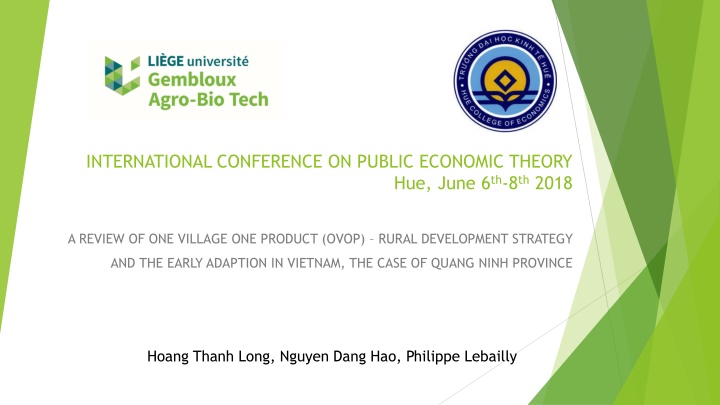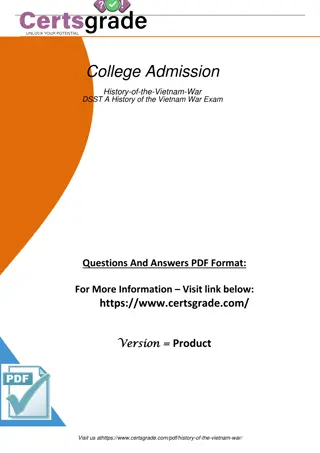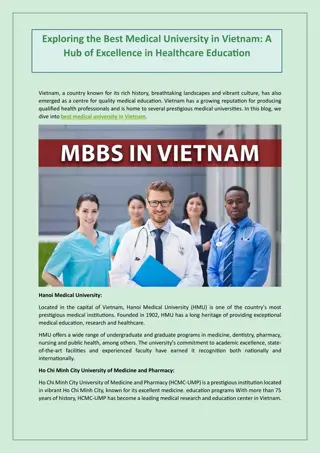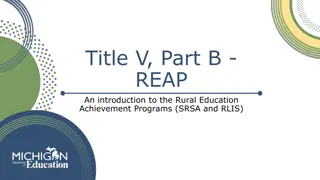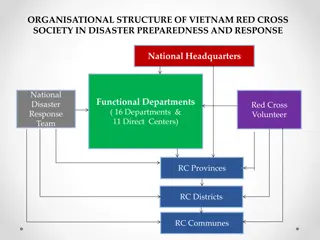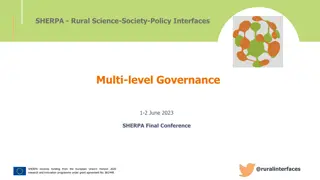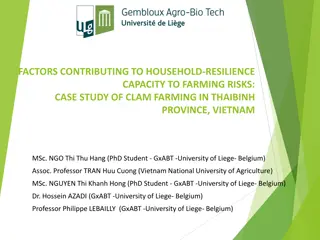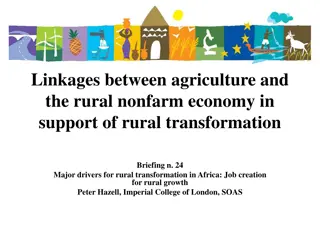Review of OVOP Rural Development Strategy in Vietnam: Case of Quang Ninh Province
International Conference on Public Economic Theory in Hue discussed the early adaptation of the One Village One Product (OVOP) rural development strategy in Vietnam, focusing on challenges, literature review, and results. The concept, theoretical basis, and implementation of OVOP were explored, highlighting its impact on local economies and community development.
Download Presentation

Please find below an Image/Link to download the presentation.
The content on the website is provided AS IS for your information and personal use only. It may not be sold, licensed, or shared on other websites without obtaining consent from the author.If you encounter any issues during the download, it is possible that the publisher has removed the file from their server.
You are allowed to download the files provided on this website for personal or commercial use, subject to the condition that they are used lawfully. All files are the property of their respective owners.
The content on the website is provided AS IS for your information and personal use only. It may not be sold, licensed, or shared on other websites without obtaining consent from the author.
E N D
Presentation Transcript
INTERNATIONAL CONFERENCE ON PUBLIC ECONOMIC THEORY Hue, June 6th-8th2018 A REVIEW OF ONE VILLAGE ONE PRODUCT (OVOP) RURAL DEVELOPMENT STRATEGY AND THE EARLY ADAPTION IN VIETNAM, THE CASE OF QUANG NINH PROVINCE Hoang Thanh Long, Nguyen Dang Hao, Philippe Lebailly
Content Introduction 1. Literature review 2. The early adaption of OVOP in Vietnam, the case of Quang Ninh province 3. Results and discussion 4.
1. Introduction Challenges for rural development: labor immigration, access to credit, market, social inequality many rural development policies have been issued by the Vietnamese Government, due to "exogenous" projects namely new varieties, new techniques, and new loans to produce chorus "high yield, low price high price, low yield endogenous development point of view shows that Vietnam has also many comparative advantages, especially in rural areas each municipality has each localities, such as traditional plants, animals or the transmitted techniques from generations of traditional production
2. Literature review 2.1. The One Village One Product (OVOP) concept Initially started in Oita Prefecture, Japan, in 1979 One village to product one competitive and marketable product with regards to their local resources Achieve sales revenue in the market, thus creating income for the residents in the villages and enhancing the local economy 143 goods with total values of $330 million in 1980 to 336 products with total values of $1,300 million in 2001 Bridging the gap between urban and rural areas in developing countries through community-based development Recently, the OVOP approach has been implemented in many Asian countries and further developing nations, including Africa and Latin America as alternative economic development path
2. Literature review 2.2. Theoretical basis for OVOP concept Targets at motivating rural development across community-based movements by utilizing indigenous resources and knowledge This strategy could be observed as being endogenous , instead of exogenous scheme While exogenous approach emphases on the function of central government and foreign companies, investment, thoughts and new knowledge to transform the resident economy, endogenous movement takes into account the responsibility and ability of local businesses and residents together with their control at the regional level Endogenous development denotes a progress of local social mobilization Where there is local control over the development process Where the development options are regionally decided The welfares of growth are retained within a region
2. Literature review 2.3. Three principles for OVOP approach Local yet global Creating globally accepted products that reflect pride in the local culture Human Resource Development Fostering of people with challenging and creative spirit Self-Reliance and Creativity Realization of OVOP through independent action utilizing the potential of the region
2. Literature review 2.3. Three principles for OVOP approach Local yet global: Creating globally accepted products that reflect pride in the local culture Self-Reliance and Creativity: This principle emphasizes independence of local actors and the attitude of government for it Local initiative, decision making, and risk-taking are keys of OVOP Government only provides supplementary support such as technical assistance and marketing Human Resource Development: Fundamental element of the initial OVOP idea Local residents are expected to have a capability for alleviating poverty issues by themselves Community leaders are expected to play a role to draw out the vitality of the localities and to facilitate their self-reliance
2. Literature review 2.4. The OVOP movement in Asian context Nations OVOP movement China One Hamlet, One Product Movement (Shanghai) One Town, One Product Movement (Shanghai) One Region, One Vista Movement (Shanghai) One Village, One Treasure Movement (Wuhan) One Community, One Product Movement (Jiangsu Province) One Product Movement (Jiangsu Province) One Village, One Product Movement (Shaanxi Province) One Village, One Product Movement (Jianxi Province) Philippines One Barangay, One Product Movement One Region, One Vision Movement Malaysia Satu Kampung, Satu Produk Movement Indonesia Back to Village (East Java) Thailand One Tambon, One Product Movement Cambodia One Village, One Product Movement Laos Neuang Muang, Neuang Phalittaphan Movement Mongolia Neg Baag, Neg Shildeg Buteegdekhuun
3. The early adaption of OVOP in Vietnam, the case of Quang Ninh province 3.1. Context of adaption Since 2000, scientists and policy makers in Vietnam have been making efforts on applying the OVOP concept, especially in agriculture context "One Village One Profession" with the highlight on craft villages in Vietnam, namely Thua Thien Hue, Binh Dinh, Ho Chi Minh City, Vinh Long,... However, the results have not been as the expectation for a number of reasons. Firstly, the limitation on understanding the OVOP approach: basic theory and principles of OVOP, implementation and application OVOP by lessons learnt in different countries Secondly, the inadequate knowledge of the current realities has also been a concern
3.2. The One Commune One Product (OCOP) strategy in Quang Ninh province In 22/10/2013, Quang Ninh, the first province in Vietnam decided to approve the program of Quang Ninh province One Commune One Product (OCOP period of 2013 2016 Objectives and principles of the OCOP program The OCOP program aims to developing the forms of organization and production of traditional and comparative products in communes, wards and townships, which contribute to the restructure Quang Ninh economy towards the endogenous development concept and increasing added value.
Principles Local Action - Towards Global This principle encourages people to recognize and take advantages of available locally resources. Thus, municipalities could develop products that have the ability to access to global markets by increasing added value for these products to meet standards for the international demand. Self-Reliance, Self-Confidence and Creativity In order to compete in the global market, local residents need to continually develop their own unique values by the spirit of self-reliance, self-confidence and creativity. Human resources development Thanks to the OCOP program, community leaders, heads of economic organizations (enterprise directors, co-operatives, and co-operative groups), qualified human resources as well as networks are created and developed in a sustainable way.
4. Results and discussion 4.1. Administration The OCOP Quang Ninh Program Management Unit (Steering Board at all levels) from provincial to district level has been established Provincial OcoP Steering Committee: chaired by Standing Vice Chairman of the Provincial People's Committee and 19 members are leaders of departments Established four committees to assist the Board of Management, including: Product Development; Promotion; Training - Communication; Administrative - General to implement the tasks according to the objectives of the scheme
Organizational system of the OCOP program Quang Ninh OCOP Executive Board Product Development Sub-committee Marketing and Trade promotion Sub-committee Training and Communication Sub-committee Administrative and General Sub-committee
4.2. Take initiative in studying, promulgating and guiding the implementation of the OCOP Program Management Tool in line with local production practices Built the intellectual property trademark identification mark for OCOP Quang Ninh Issue the OCOP Annual OCOP Cycle and OCOP Implementation Guideline, in line with the proposed bottom-up approach Issue the evaluation and classification of OCOP products
Training, Consultation Training 1 Training 2 Evaluate products at district/ provincial level Publicity Receive business plan Receive product ideas Implement business plan Promotion Guide Fail 1 time Fail 2 time Fail 3 time Join next year 3 4 5 6 7 8 12 3 5 6 Month Figure 4. The annual OCOP implementation in Quang Ninh
4.3. Economic organizations (small and medium enterprises, cooperatives, cooperative groups, groups of production households) have rapidly developed in size and quantity in the direction of raising the value of their products and developing production according to the value chain. The OCOP sales reached over 672 billion VND. Job creation increased by over 2,000 workers. Additionally, the OCOP program has introduced 180 new economic organizations (94 households, 36 cooperatives, 32 enterprises, 11 group production, and 7 associate production). More than 210 products were registered to participate in the OCOP program. These products were granted with the OCOP brands, of which 99 products met standards from 3 to 5 stars.
6%4% 18% 52% 20% Households Cooperatives Enterprises Group production Associate Production Figure 3. Type of producers under OCOP program in Quang Ninh (2013-2016)
OCOP Products 2014-2016 250 198 200 150 120 100 48 50 0 2014 2015 Number of Products 2016
